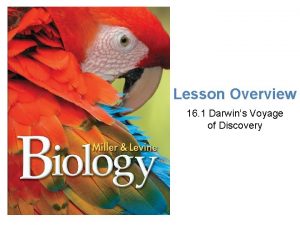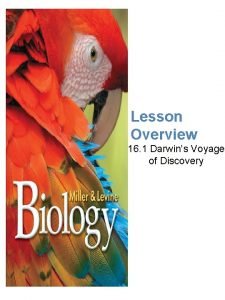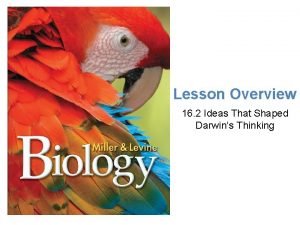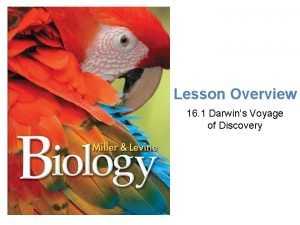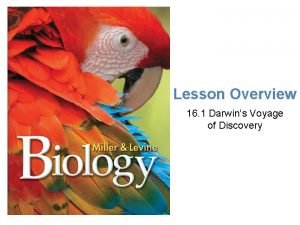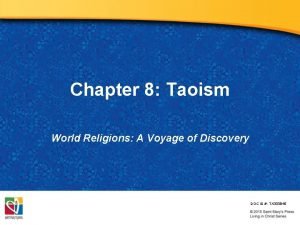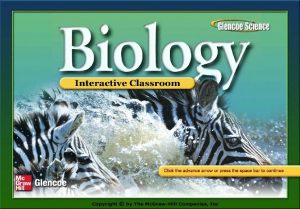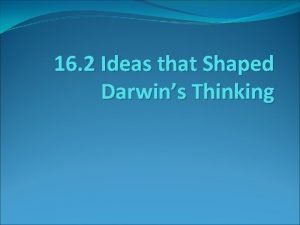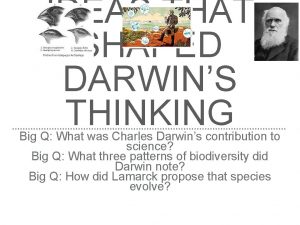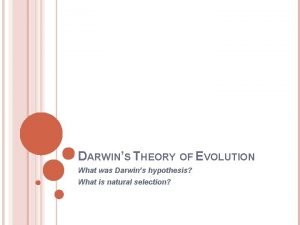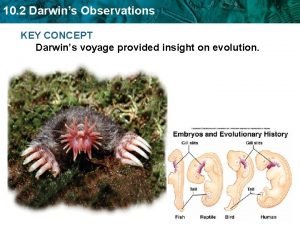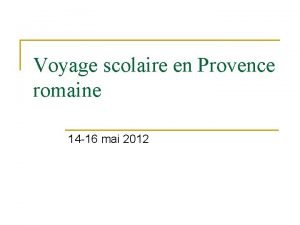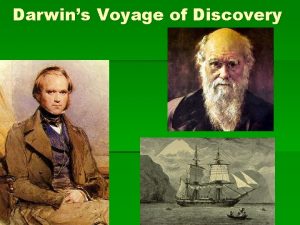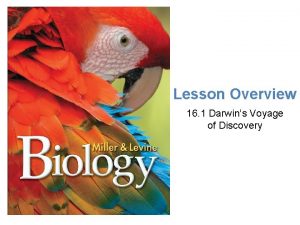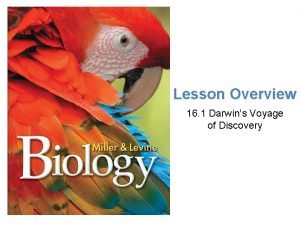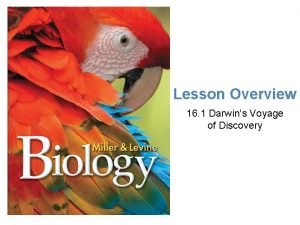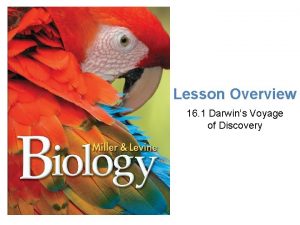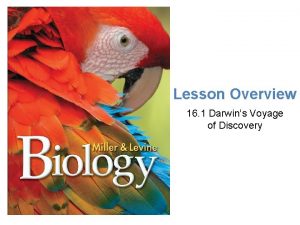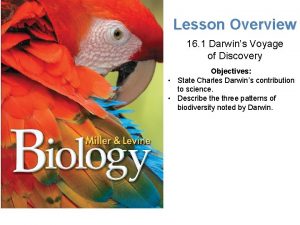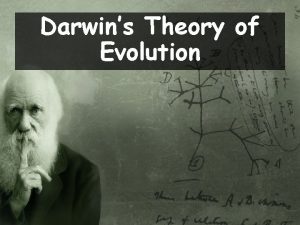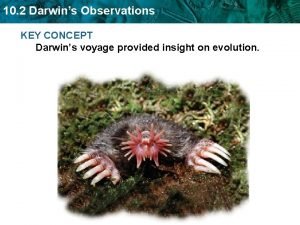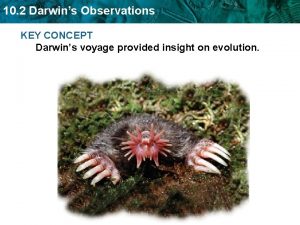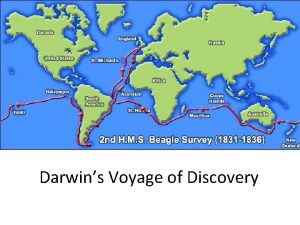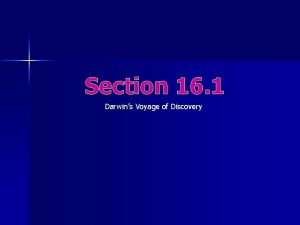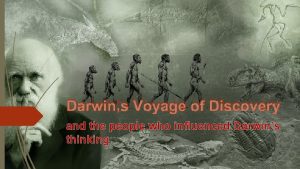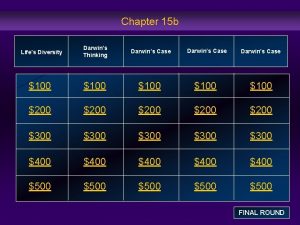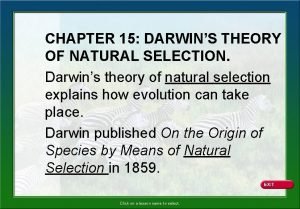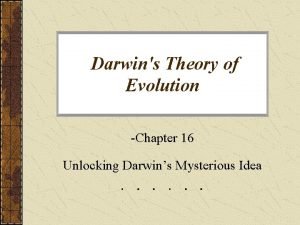Lesson Overview 16 1 Darwins Voyage of Discovery























- Slides: 23

Lesson Overview 16. 1 Darwin’s Voyage of Discovery

Darwin’s Epic Journey - Charles Darwin was born in England on February 12, 1809. - He grew up at a time when the scientific view of the natural world was shifting dramatically. - Darwin developed a scientific theory of biological evolution that explains how modern organisms evolved over long periods of time through descent from common ancestors evolution

Darwin’s Epic Journey (cont. ) - 5 year voyage HMS Beagle’s five-year mapping the coastline of South America. - Wanted to explain the biological diversity he observed in a scientific way. - Darwin noticed three distinctive patterns of biological diversity: (1) Species vary globally, (2) species vary locally, and (3) species vary over time.

Species Vary Globally - Darwin noticed that different, yet ecologically similar, animal species inhabited separated, but ecologically similar, habitats around the globe. – Ex: Australia’s kangaroos were no where else to be found

Species Vary Locally - Darwin noticed that different, yet related, animal species often occupied different habitats within a local area. - Ex: Galapagos Islands which are close together but have different ecological conditions which lead to very distinct giant tortoises.

Species Vary Locally (cont. ) – Ex. Darwin’s Finches beak structure varied depending on their diet.

Species Vary Over Time - Darwin also collected fossils, which are the preserved remains or traces of ancient organisms. - Darwin noticed that some fossils of extinct animals were similar to living species.

Putting the Pieces of the Puzzle Together - The evidence suggested that species are not fixed and that they could change by some natural process.

Lesson Overview 16. 2 Ideas That Shaped Darwin’s Thinking

An Ancient, Changing Earth – By Darwin’s time, the relatively new science of geology was providing evidence to support new and different ideas about Earth’s history. – Hutton and Lyell concluded that Earth is extremely old and that the processes that changed Earth in the past are the same processes that operate in the present.

Hutton and Geological Change – Hutton proposed most of Earth’s features were formed from processes that operate very slowly. Therefore he concluded that our planet must be much older than a few thousand years. – Hutton introduced a concept called deep time—the idea that our planet’s history stretches back over a period of time so long that it is difficult for the human mind to imagine—to explain his reasoning.

Lyell’s Principles of Geology – Lyell presented a way of thinking called uniformitarianism, the idea that the geological processes we see in action today must be the same ones that shaped Earth millions of years ago. – Darwin asked himself, if Earth can change over time, could life change too?

Lamarck’s Evolutionary Hypotheses – In 1809, the French naturalist Jean. Baptiste Lamarck proposed the hypothesis that organisms could change during their lifetimes by selectively using or not using various parts of their bodies. – He also suggested that individuals could pass these acquired traits on to their offspring, enabling species to change over time.

Lamarck’s Ideas – Lamarck proposed that all organisms have an inborn urge to become more complex and perfect, and to change and acquire features that help them live more successfully in their environments.

Lamarck’s Ideas – Structures of individual organisms could also change if they were not used. If a bird stopped using its wings to fly, for example, its wings would become smaller. – Traits altered by an individual organism during its life are called acquired characteristics.

Lamarck’s Ideas – Lamarck also suggested that a bird that acquired a trait, like longer legs, during its lifetime could pass that trait on to its offspring, a principle referred to as inheritance of acquired characteristics.

Evaluating Lamarck’s Hypotheses – Today, we know that Lamarck’s hypotheses were incorrect in several ways. – Organisms don’t have an inborn drive to become more perfect. Evolution does not mean that over time a species becomes “better” somehow, and evolution does not progress in a predetermined direction. – In addition, traits acquired by individuals during their lifetime cannot be passed on to offspring.

Evaluating Lamarck’s Hypotheses – However, Lamarck was one of the first naturalists to suggest that species are not fixed. – He was among the first to try to explain evolution scientifically using natural processes. – He also recognized that there is a link between an organism’s environment and its body structures.

Population Growth – In 1798, English economist Thomas Malthus noted that humans were being born faster than people were dying, causing overcrowding. – He reasoned that if the human population grew unchecked, there wouldn't’t be enough living space and food for everyone.

Population Growth – Darwin realized that Malthus’s reasoning applied even more to other organisms than it did to humans. – Darwin had become convinced that species evolved, but he needed a scientific explanation based on a natural process to explain how and why evolution occurred.

Artificial Selection – To find an explanation for change in nature, Darwin studied change produced by plant and animal breeders. – Breeders knew that individual organisms vary, and that some of this variation could be passed from parents to offspring and used to improve crops and livestock.

Artificial Selection – Darwin called this selective breeding process artificial selection, a process in which nature provides the variations, and humans select those they find useful. – Darwin put artificial selection to the test by raising and breeding plants and fancy pigeon varieties.

Artificial Selection – Darwin recognized that natural variation was very important because it provided the raw material for evolution. – When Darwin published his scientific explanation for evolution, it changed the way people understood the living world.
 Species vary locally
Species vary locally Lesson 1 darwins voyage of discovery
Lesson 1 darwins voyage of discovery Voyage voyage
Voyage voyage Chanson sur le thème du voyage
Chanson sur le thème du voyage Ideas that shaped darwin's thinking
Ideas that shaped darwin's thinking Explanation
Explanation Species vary locally examples
Species vary locally examples World religions a voyage of discovery
World religions a voyage of discovery Ideas that shaped darwin's thinking
Ideas that shaped darwin's thinking Www.bf.tku.edu.tw/files/news chapter 17
Www.bf.tku.edu.tw/files/news chapter 17 Chapter 15 section 1 darwins theory of natural selection
Chapter 15 section 1 darwins theory of natural selection Section 15-2 ideas that shaped darwins thinking
Section 15-2 ideas that shaped darwins thinking Section 2 darwins observations study guide a
Section 2 darwins observations study guide a Ideas that shaped darwin's thinking answer key
Ideas that shaped darwin's thinking answer key What was darwins theory
What was darwins theory Darwins observations
Darwins observations Chapter 9 lesson 2 photosynthesis an overview
Chapter 9 lesson 2 photosynthesis an overview Lesson overview
Lesson overview Que faut il emmener en voyage scolaire
Que faut il emmener en voyage scolaire Voyage scolaire baux de provence
Voyage scolaire baux de provence Voyage scolaire herculanum
Voyage scolaire herculanum Voyage scolaire dublin
Voyage scolaire dublin Voyage estimation
Voyage estimation Voyage au pays des maths
Voyage au pays des maths
